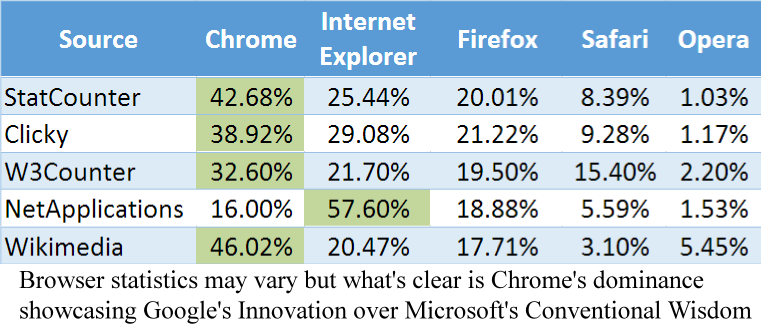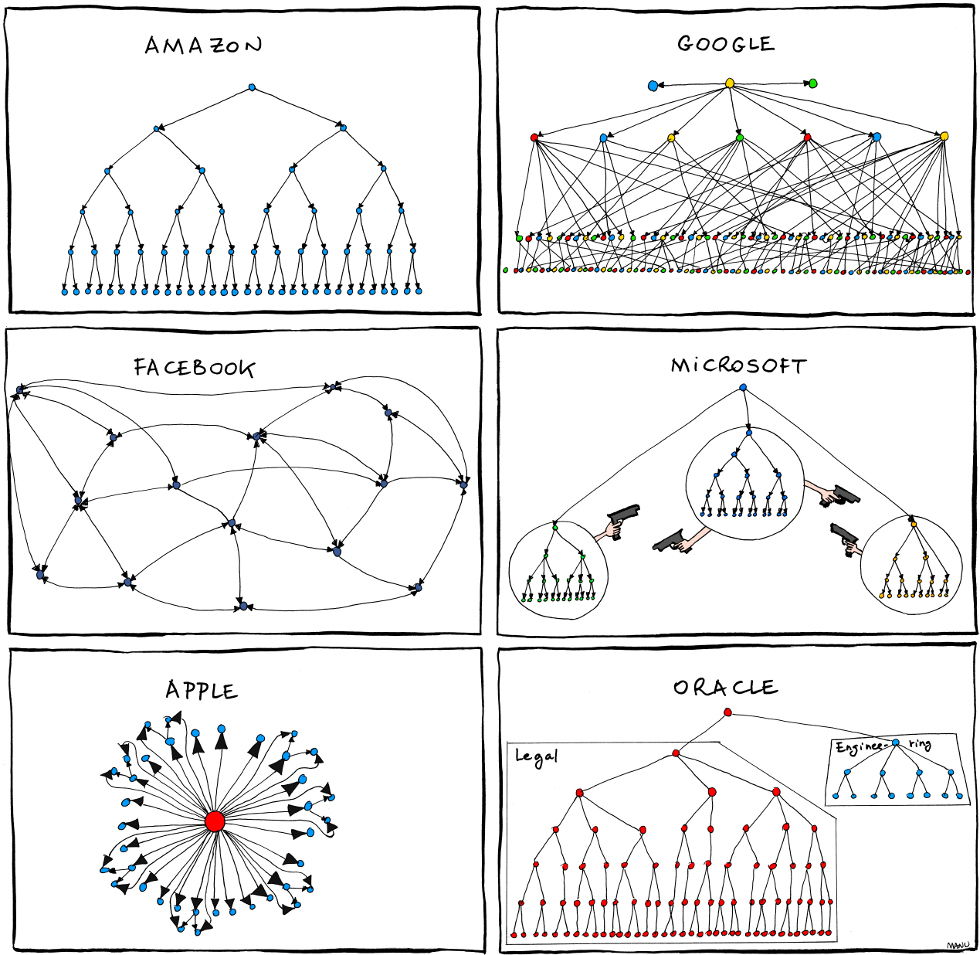A relatively well known story in the tech community, is how Microsoft missed out on the opportunity to release an online office Suite, touting the benefits of cloud computing.
What could have been a revolutionary idea, securing Microsoft's dominance in personal computing in the years ahead, instead amounted to a whiff. They passed, leaving the door for an at-the-time smaller competitor to walk right in, that competitor was Google.
Google's dominance was fully realized seven years ago with the introduction of Gmail and then Google Docs. Google's Search Engine had already garnered wide acclaim and dominate market share, but was limited in it's role as a go-between. Gmail on the other hand was a prime destination for people's time spent online. From there Google kept on growing it's list of services promising the quality of the Google brand of code.

Microsoft went in the other direction. Revenues are still astronomical on the back of business products & services, but what about their current standing in the tech market? Their market shares have been dropping across the board (IE, PC's, desktop and mobile OS, even the once invincible Office Suite) while their brand image has dropped to the pits.
The early plan to grow cloud services was nipped in the bud by the MS Office division, who back in the day was the second biggest revenue stream for Microsoft. Not wanting a new division encroaching on their territory, the powers-that-be decided to scratch the whole initiative. The rest is history.

Of course the more well known story regarding missed opportunities by Microsoft is it's incredibly late arrival to the smartphone market. Older folks will remember that back when Palm Pilots were a thing, Microsoft was actually the first to introduce mobile devices in Pocket PC's and also had tablet computers on the market back since 2002. These two categories can be chalked up to not delivering a product people wanted, but a large reason why the devices never caught on was reluctant clinging to resistive screens requiring stylus for accurate input, and a lack of design overhaul needed to enhance the mobile platform.
Plainly speaking, Microsoft rested on the laurels of it's vast conventional wisdom, porting over PC functionality which was already proven rather than start from scratch with new design for the new platform.
With cloud services, the same story is evident. Microsoft has a way of doing things, and use that to direct new initiatives. Which is a good way to find yourself looking back at missed opportunities.
Online cloud services and Mobile computing, in other words the two biggest aspects of the tech boom. Two pretty large missed opportunities.
The benefits of conventional wisdom are obvious. Of course it's a benefit to pay attention to the top expert opinions of the day. But history is also scattered with stories where the top authorities and competitors became obsolete riding conventional wisdom straight into the ground.
The trouble with the status quo is that you'll think it'll stay the same forever, right until the minute everything changes. So how do you look to the future to see that change coming, to avoid looking at missed opportunities in your past?
Organization structure-
Dissecting organizational structure would require a thesis, and can't be properly detailed in an article, despite many valiant attempts from almost every news source. The deeper solutions reside in layered and historical context. Properly comprehending that context is almost as essential as constructing a solution for it.
Let's instead look at some universal goals an organizational structure should have, with their accompanying priority hierarchy. Some are self explanatory, but understanding the balance well is how companies get positive balance sheets, providing greater leverage for future investments, leading to growth.

Designer Manu Cornet famously illustrated the difference between the organizational structure of the top tech companies.
Notorious for their silo'd divisions and products, Microsoft developed a culture of competition between divisions within the company. Serving as a valuable demonstration of how a company can become stymied by success. Microsoft was ruled by an entrenched power structure reinforced by heaps of revenue. Change was discouraged, instead the company followed a very specific roadmap. Besides operating solely by the book, the business process also lacked respect for employee time. It's widely reported by ex-employees that too much time was spent on procedural work, distracting discipline with wasted development time (Conversely, Google was widely lauded for it's 20% employee free time referred to as "creative time" where employees are free to chose their own tasks1NY Times- The Google Way .) Besides distracting employees attention, forced busy work saps motivation and effort.
Full utilization of the workforce should a top priority for any organizational structure. Every company spends strenuous attention balancing the payroll, an optimized workforce can more valuable. An engaged and motivated staff can be one of the most valuable resources for a company: less mistakes get made, more attention to detail, improved and inspired work. Employees should be encouraged to be invested in the company, to take care of their personal efforts and responsibilities. Rather than a bunch of people complaining about their work environment, complaining about their work load, and letting work slide because there is no motivation.
If a company is going to employ a staff, it is simply in their interest to receive the best possible potential for employees rather than force them to compromise their qualities. Another instance where Microsoft failed
Instead of working to develop the new, they concentrated on protecting the old.
Business Process-
When it comes to Business Process, most companies sacrifice Process Dexterity for Process Integrity. Process Integrity is the more straightforward task, ensuring no mistakes are made, no losses are incurred which could have been avoided, protecting IP, etc.
Process dexterity is a tougher nut to crack. First, a company must recognize that they won't always be right. For decision makers earing multi-million dollar salaries and a wall full of credentials, this can be a hard pill to swallow. But it's the most simple truth out there, so companies would be wise to account for it accordingly.
Huge corporations with strong minded CEO's are unlikely to adapt despite plenty of reasons, but smaller businesses can still learn from these lessons and adjust their forward models. Making Process Dexterity an important object is valuable for Business Process. Rather than focusing solely on minimizing mistakes and locking down a process, it is wise to allow for modifications to adapt over time.
Companies would rather miss out on a good opportunity than make a bad decision.
Allowing for Process Dexterity will allow for easier identification for improvements. This opens the door for opportunities to be addressed in a timely manner, avoiding costly stop-gaps between implementation changes.
Decision Process-
Similar to Business Process, a decision making structure depends heavily on the people involved, and intricacies of the initiative. It's tough to pinpoint causes of institutional failure with design-by-committee, but here are some universal questions which can indicate a problem-
1) Are all decisions based on established precedent? Basically saying this is what we'll do, because this is what worked before. Great general strategy, horrible if that generalization is used across the board. Guaranteed to fail over time, because you wont be adapting and evolving your business. Expansion and innovation are necessary for business to grow and stay relevant, resistance to the new will never work out in the long run.
2) Are decisions reached by the consensus of appropriate people relevant to a situation or are a handful of people making every important decisions? - A small group of decision makers is good for maintaining consistency, but horrible for dynamically adjusting. Even the brightest minds cannot be right 100% of the time. It's also harder to realize mistakes when a small group of people is entrenched in their beliefs. Considering input from a larger group alleviates the burden on decision makers, and makes it easier to recognize new opportunities.
3) What is the recent track record of decisions made? This last question should be simple. Have we performed as well as we should have the last 3 years? If not, what have we failed to do? Problem is a lot of people will blame circumstances outside their control, rather than evaluating self-performance. Regardless of market conditions, the decision process should always be immediately re-evaluated following poor results.
Disconnect between concept and execution-
As the cumulative result of the other categories, this is another area where Microsoft shows every promise of success but fails to deliver. Concept videos are by no means an accurate portrayal of future success, but they do demonstrate a company's understanding of what consumers want. If a concept video succeeds in grasping the attention and desire of consumers, what happens in the development process which goes wrong?
Listen to design. Every company has a hierarchy of design, but where is the emphasis situated? Google and most tech companies laud developers. Corporations chase MBA's. Marketing is all about design. What's the trick? Listen to all three. Each are as important to any business, even in smaller capacities. Developers create functionality, Designers ensure user experience, business ensures capitalization of opportunity.
Looking at Microsoft it's easy to see which function they listen to the least. Basically the only thing designers had been used for were creating those concept videos, which is a shame since they're always on to something really great. By tapping into the benefits highlighted in a concept, a company should prioritize not compromising goals to appease stringent business processes or decision makers.
___________
At the end of the day capitalism takes care of business by ushering out the old and ineffective while embracing new companies that display more effective methods. Large companies like Microsoft have plenty of resources to endure a dry spell, but resources will dissipate quickly if no changes are made. Smaller businesses on the other hand have less leeway, but greater flexibility to adapt their business structure to adapt to new conditions. In either case it's important to understand the goals for Organizational Structure, Business Process, and Decision Process. Then deliver on a quality product. Sounds simple doesn't it?





